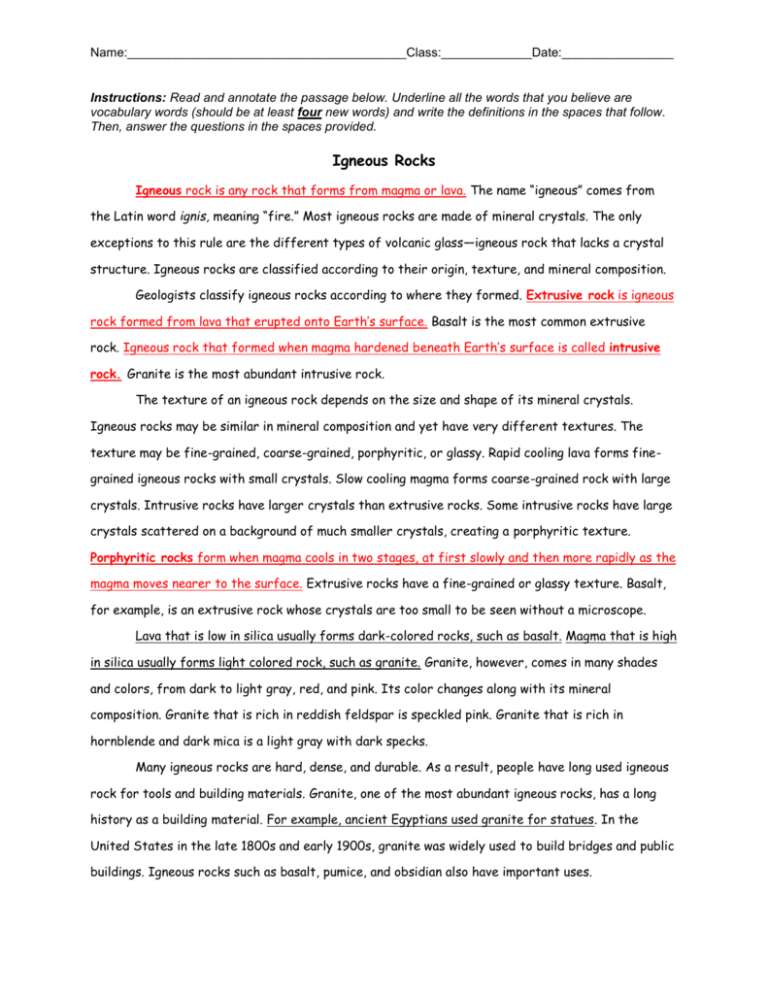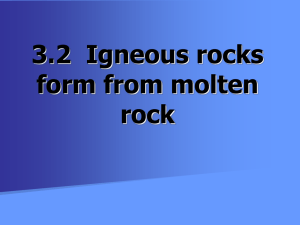File
advertisement

Name:________________________________________Class:_____________Date:________________ Instructions: Read and annotate the passage below. Underline all the words that you believe are vocabulary words (should be at least four new words) and write the definitions in the spaces that follow. Then, answer the questions in the spaces provided. Igneous Rocks Igneous rock is any rock that forms from magma or lava. The name “igneous” comes from the Latin word ignis, meaning “fire.” Most igneous rocks are made of mineral crystals. The only exceptions to this rule are the different types of volcanic glass—igneous rock that lacks a crystal structure. Igneous rocks are classified according to their origin, texture, and mineral composition. Geologists classify igneous rocks according to where they formed. Extrusive rock is igneous rock formed from lava that erupted onto Earth’s surface. Basalt is the most common extrusive rock. Igneous rock that formed when magma hardened beneath Earth’s surface is called intrusive rock. Granite is the most abundant intrusive rock. The texture of an igneous rock depends on the size and shape of its mineral crystals. Igneous rocks may be similar in mineral composition and yet have very different textures. The texture may be fine-grained, coarse-grained, porphyritic, or glassy. Rapid cooling lava forms finegrained igneous rocks with small crystals. Slow cooling magma forms coarse-grained rock with large crystals. Intrusive rocks have larger crystals than extrusive rocks. Some intrusive rocks have large crystals scattered on a background of much smaller crystals, creating a porphyritic texture. Porphyritic rocks form when magma cools in two stages, at first slowly and then more rapidly as the magma moves nearer to the surface. Extrusive rocks have a fine-grained or glassy texture. Basalt, for example, is an extrusive rock whose crystals are too small to be seen without a microscope. Lava that is low in silica usually forms dark-colored rocks, such as basalt. Magma that is high in silica usually forms light colored rock, such as granite. Granite, however, comes in many shades and colors, from dark to light gray, red, and pink. Its color changes along with its mineral composition. Granite that is rich in reddish feldspar is speckled pink. Granite that is rich in hornblende and dark mica is a light gray with dark specks. Many igneous rocks are hard, dense, and durable. As a result, people have long used igneous rock for tools and building materials. Granite, one of the most abundant igneous rocks, has a long history as a building material. For example, ancient Egyptians used granite for statues. In the United States in the late 1800s and early 1900s, granite was widely used to build bridges and public buildings. Igneous rocks such as basalt, pumice, and obsidian also have important uses. Name:________________________________________Class:_____________Date:________________ Vocabulary 1. Igneous rock is any rock that forms from magma or lava. 2. Extrusive rock is igneous rock formed from lava that erupted onto Earth’s surface. 3. Igneous rock that formed when magma hardened beneath Earth’s surface is called intrusive rock. 4. Porphyritic rocks form when magma cools in two stages, at first slowly and then more rapidly as the magma moves nearer to the surface. 5. Various other words: granite, basalt, 6. Explain how the silica content of molten material affects the color of igneous rocks. Lava that is low in silica usually forms dark-colored rocks, such as basalt. Magma that is high in silica usually forms light colored rock, such as granite. 7. What qualities of igneous rocks have long made them useful for tools and building materials? 8. Describe one use each for the igneous rocks granite, basalt, and pumice. Ancient Egyptians used granite for statues. (Basalt is used as a construction gravel, and pumice as an abrasive in polishes – from text book.) Fill in the blank to complete each statement. 9. Igneous rock formed from lava on Earth’s surface is called extrusive rock. 10. A rock with large crystals scattered on a background of much smaller crystals has a(n) porphyritic texture. 11. Igneous rock formed from magma below Earth’s surface is called intrusive rock.








